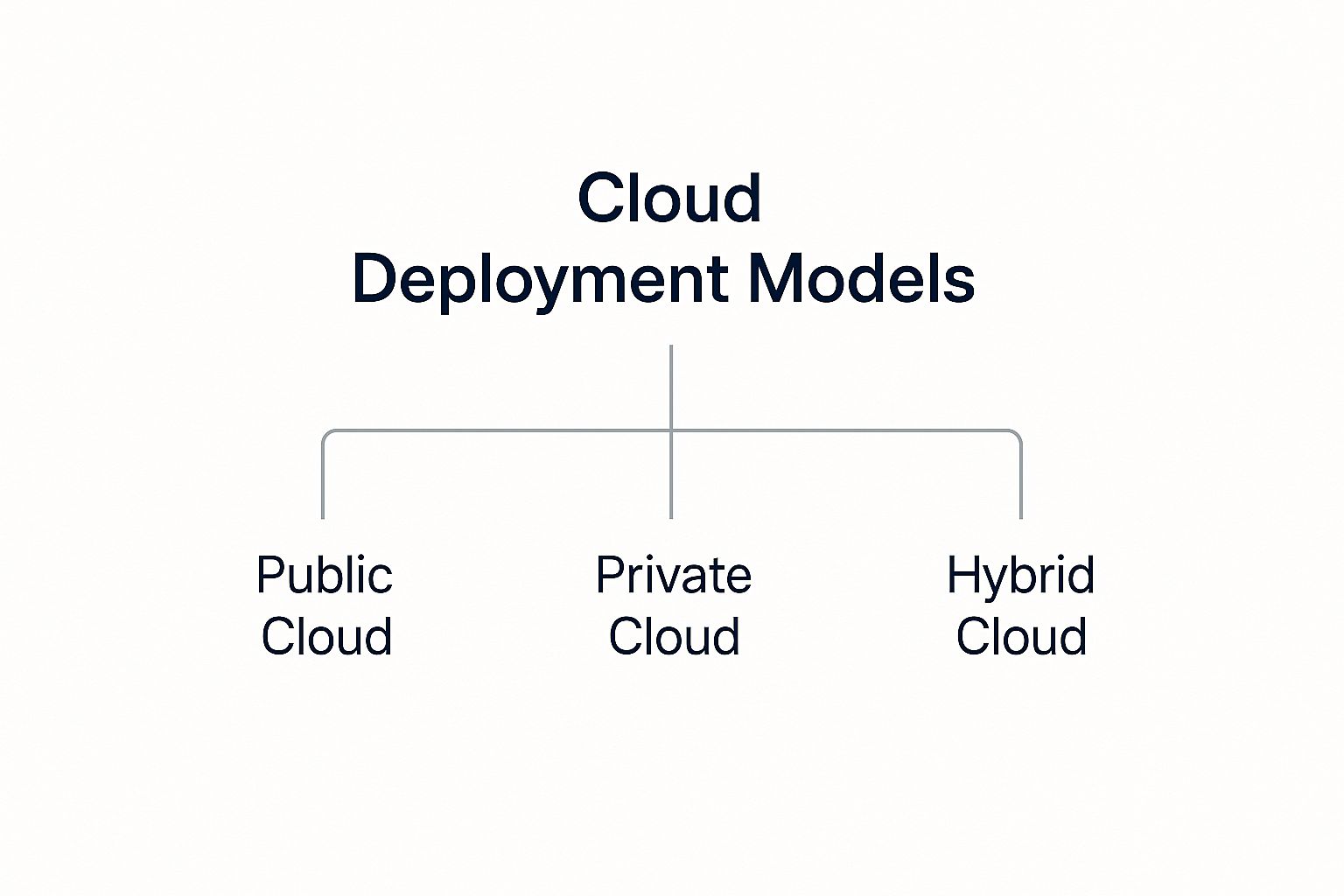A cloud deployment model really just answers two simple questions: where does your computing infrastructure live, and who is in charge of it? Think of it like deciding whether to rent an apartment, build your own private home, or maybe even do a little of both. A cloud deployment models diagram is the blueprint that lays out these options, usually showing Public, Private, and Hybrid clouds to give you a quick grasp of the fundamental differences.
Visualising Your Cloud Strategy
Choosing a cloud model is one of those foundational decisions that will echo through everything you do, from your monthly budget and scalability plans to your security posture and compliance obligations. It's not just a technical box to tick; it's a strategic move that shapes how your entire organisation will operate and grow. Getting your head around the core models is the first real step towards building an efficient, secure, and cost-effective tech backbone for your business.
Each model strikes a different balance between control, flexibility, and cost. There’s no single "best" choice here—only the one that fits your specific goals, budget, and regulatory headaches. An organisation handling highly sensitive financial data is going to have wildly different needs than a startup trying to get a new mobile app off the ground.
This simple cloud deployment models diagram gives you a clear look at the primary structures.

As the diagram shows, the core decision really boils down to using shared (Public) versus dedicated (Private) infrastructure, with the Hybrid model acting as a bridge between the two worlds.
Key Deployment Models Explained
To make a smart choice, you need to understand what each of these models actually represents. The main types of cloud deployment you'll encounter are:
- Public Cloud: All the resources are owned and managed by a third-party provider (like AWS or Azure) and are shared among many different organisations over the internet.
- Private Cloud: The entire infrastructure is dedicated exclusively to one organisation, giving them the highest level of control and security.
- Hybrid Cloud: This is a mix-and-match approach, combining public and private clouds and letting data and apps move between them for maximum flexibility.
- Multi-Cloud: This strategy involves using services from more than one public cloud provider. It's a great way to avoid being locked into a single vendor and pick the best service for each specific job.
A cloud deployment model is the operational approach your company has chosen to support a particular computing workload. A company often has multiple cloud deployment models when it has many workloads.
Ultimately, the structure you land on will dictate your application's architecture. To get a better feel for how these choices influence the actual system design, it's worth exploring our guide on creating a cloud application architecture diagram. This knowledge is absolutely crucial for planning a solution that's both robust and ready to scale.
The Public Cloud Powering Scalability
The public cloud is the engine behind so much of modern digital life, powering everything from scrappy startups to massive global companies. The best way to think about it is like tapping into your city’s electrical grid. You get instant access to immense power without the eye-watering cost and headache of building your own power plant. You just pay for what you use, when you use it.
This whole model is built on the idea of sharing. Cloud service providers like Amazon Web Services (AWS), Microsoft Azure, and Google Cloud own and run colossal data centres, offering up their computing, storage, and networking resources to anyone over the internet. This completely wipes out the need for any upfront cash spend on hardware, which is a total game-changer for businesses that need to move fast.

This shared infrastructure is the secret sauce behind its most famous benefit: near-infinite scalability. A small e-commerce site can handle a sudden, massive traffic spike during a flash sale by automatically grabbing more resources, and then scale right back down when the rush is over.
Understanding the Trade-Offs
But all this convenience comes with a few important things to keep in mind. The public model runs on a shared responsibility model when it comes to security. While the provider secures the underlying infrastructure (the "cloud" itself), you are on the hook for securing everything you put in the cloud, from your data to your applications.
Another key point is managing your costs. The pay-as-you-go pricing is fantastic for flexibility, but it can lead to some nasty surprises on your bill if you're not watching it closely. A misconfigured service or a runaway process can quickly inflate your monthly spend, making solid financial operations (FinOps) an absolute must.
In a public cloud, tenants are isolated from each other, but they still share the same physical hardware. This can sometimes lead to the "noisy neighbour" effect, where a resource-heavy application used by another tenant can potentially impact the performance of your own.
Finally, while the providers offer tons of customisation options, you ultimately have less granular control over the hardware and underlying architecture than you would in a private setup.
Who Should Use the Public Cloud
The public cloud is an ideal fit for a massive range of use cases, making it a versatile tool for just about any organisation. It’s particularly brilliant for:
- Startups and SMBs: Businesses with limited capital can launch and grow without a huge upfront investment in hardware.
- Variable Workloads: Applications with unpredictable traffic, like streaming services or retail sites, get huge benefits from elastic scalability.
- Development and Testing: Teams can spin up and tear down entire environments quickly and cheaply without tying up permanent resources.
The principles of the public cloud are foundational to building any modern application. To see how these ideas translate into real-world design, you should explore our guide on creating a scalable system architecture.
The Private Cloud: Prioritising Control
If the public cloud is like tapping into the city's power grid, then the private cloud is your own personal power plant. This model is the fortress of the cloud world, built for a single organisation that needs absolute authority over its data, infrastructure, and security. It's an exclusive, single-tenant environment where resources aren't shared with anyone else.
This dedicated setup gives you unparalleled control. You can fine-tune the architecture to meet the exact performance needs of critical applications and enforce strict security policies that just aren't possible in a shared space. This is precisely why industries handling sensitive information—like finance, healthcare, and government—often go this route to meet tough compliance standards like GDPR or HIPAA.

This diagram shows the clear boundary of a private cloud. All resources are contained within a single organisation's control, whether they're hosted on-site or by a third party.
Weighing the Benefits and Costs
The main perks of a private cloud boil down to security and customisation. Because the infrastructure is all yours, performance is highly predictable, free from the "noisy neighbour" effect you sometimes get in public clouds. This isolation is also crucial for meeting strict data sovereignty and residency rules.
However, this level of control comes at a price. Private clouds demand a significant upfront investment in hardware, not to mention the ongoing operational costs of maintenance, updates, and management. You also need a skilled in-house IT team to run the show effectively, which can be a substantial long-term expense.
To really get a feel for the control a private cloud offers, it helps to understand the differences between private cloud and on-premise solutions, as they are related but distinct concepts.
Private Cloud in Action
Government agencies are a perfect real-world example of the private cloud's value. In India, initiatives like Digital India and the Smart Cities Mission have fuelled massive growth in the government cloud sector. The market, currently valued at around USD 1.4 billion, is expected to hit USD 4.24 billion by 2033.
These deployments are essential for modernising public services while sticking to strict data localisation mandates, which supports India’s digital sovereignty goals.
A private cloud is the ultimate choice for organisations where the cost of a security breach or compliance failure far outweighs the higher expense of dedicated infrastructure. It’s a strategic investment in control and peace of mind.
This model is the best fit for:
- Highly Regulated Industries: Organisations in finance, healthcare, and government that must follow strict data protection laws.
- Mission-Critical Workloads: Applications that need guaranteed performance and minimal latency.
- Large Enterprises: Companies with the capital and technical expertise to build and maintain their own cloud environment.
The Hybrid Cloud: Balancing Flexibility and Security
The hybrid cloud is the strategic middle ground, giving you the best of both worlds. It perfectly blends the rock-solid control you get from a private cloud with the sheer agility of the public cloud.
Think of it like a big retail business. They own their flagship stores for consistent, secure, day-to-day operations—that's their private cloud. But when the holiday season hits, they open temporary pop-up shops in busy shopping centres to handle the massive surge in demand. That's their public cloud. This isn't just a compromise; it's a very deliberate and powerful strategy.
Organisations create a unified, automated infrastructure by connecting their private and public cloud environments. This lets them keep their most sensitive customer data or mission-critical applications safe and sound on-premises while tapping into the public cloud's enormous, scalable resources for other jobs.
A huge business driver for going hybrid is cost. You can keep your baseline operations running on private infrastructure where costs are predictable, which helps you avoid paying a fortune to over-provision for demand spikes that only happen a few times a year.
Weaving Two Worlds Together
The real magic of a hybrid setup is its flexibility. It allows workloads to move smoothly between the two environments, a concept known as cloud bursting. For instance, a data analytics application can chug along on the private cloud but "burst" into the public cloud when it needs extra computing muscle for a massive job. This guarantees performance without you having to buy expensive new hardware that would sit idle most of the time.
This model has also become a cornerstone of modern disaster recovery plans. An organisation can replicate its critical systems from its private cloud to a public cloud provider. If an outage ever hits their on-premise setup, operations can failover to the public cloud, keeping the business running with minimal disruption.
The hybrid model is the default for many modern enterprises because it acknowledges a fundamental reality: not all data and applications are created equal. It provides a tailored environment where each workload runs in the most suitable location based on its specific security, performance, and cost requirements.
This approach is catching on in a big way globally. In India, the cloud computing market is exploding, valued at USD 21.82 billion and expected to hit USD 58.73 billion by 2030. Hybrid cloud is the fastest-growing part of this market, expanding at a 28.4% compound annual growth rate as businesses try to balance strict regulatory compliance with performance needs. You can find more insights in this report on the Indian cloud computing market.
Common Hybrid Cloud Use Cases
A good cloud deployment models diagram for a hybrid setup would show this secure, orchestrated link between private and public environments. It’s a great way to visualise how data and applications can flow between them, highlighting its value in a bunch of different scenarios:
- Dynamic Workloads: Businesses with fluctuating needs, like e-commerce sites or media streaming services, can easily handle massive traffic spikes using the public cloud's elastic resources.
- Big Data Processing: Companies can keep their sensitive raw data stored safely on a private cloud and then shift it to a powerful public cloud analytics platform for heavy-duty processing.
- Phased Cloud Migration: It offers a practical and less disruptive path for organisations to move to the cloud gradually. They can migrate less critical applications first while keeping their core, legacy systems in-house for a while longer.
The Multi-Cloud Strategy: Avoiding Vendor Lock-In
While it’s often mixed up with a hybrid setup, a multi-cloud strategy is a totally different beast. Think of it like a master chef who sources ingredients from different expert suppliers—artisan cheeses from one, rare spices from another—instead of just buying everything from a single supermarket. This model doesn't necessarily even involve a private cloud.
Instead, a multi-cloud strategy means you're using services from more than one public cloud provider at the same time. An organisation might use Amazon Web Services (AWS) for its bulletproof database services while leaning on Google Cloud for its top-tier artificial intelligence and machine learning tools. This "best-of-breed" approach lets you cherry-pick the perfect technology for each specific job, squeezing the most out of performance and cost.

As you can see, the organisation is pulling distinct services from several providers. This is a far cry from the tightly integrated nature of a true hybrid cloud.
Key Drivers for a Multi-Cloud Approach
One of the biggest motivations for going multi-cloud is to dodge vendor lock-in. By spreading your workloads across different platforms, you keep your negotiating power and avoid becoming too dependent on a single provider’s ecosystem, pricing, and tech roadmap. That kind of strategic independence is a huge long-term advantage.
This approach is now the standard for Indian enterprises. Recent surveys show that a staggering 89% of enterprises in India have adopted a multi-cloud strategy. On average, an organisation uses services from roughly 3.4 different cloud providers to make sure workloads are running optimally and to maintain flexibility. To get a better feel for these trends, you can explore more about India's cloud market growth.
Multi-cloud is a conscious business decision to use the best tool for the job. It’s about building a resilient, high-performing, and cost-effective technology stack without being tied to a single vendor's limitations.
Other major benefits include:
- Increased Resilience: If one cloud provider has an outage, your critical applications can keep chugging along on another. This dramatically improves overall business continuity.
- Cost Optimisation: It sparks competitive pricing. You can shift workloads to whichever provider offers the best bang for your buck on a particular service.
- Improved Performance: By choosing providers with data centres closer to your end-users in different parts of the world, companies can slash latency and make the user experience much snappier.
How to Choose the Right Cloud Model
Alright, so we've covered the "what." Now for the "how." Turning all this theory into a practical decision means you need a solid framework. Choosing a cloud model isn’t about picking the “best” one on the market; it’s about finding the one that fits your business goals, budget, and the rules you have to play by. Let's ditch the generic advice and get into the factors that actually matter.
A good starting point is to look at your workloads. A fintech startup handling sensitive financial data is naturally going to lean towards a private or hybrid setup for that extra layer of security and compliance. On the flip side, a media company getting ready for a massive live event with unpredictable traffic spikes would find the public cloud’s elastic scalability a lifesaver.
Key Factors for Your Evaluation
To make a smart choice, you have to weigh a few critical factors against each other. Each one will pull you in a different direction, so the real trick is finding the right balance for your unique situation.
Think of it as balancing four pillars:
- Cost: Do you prefer predictable, upfront capital expenses (Private) or flexible, pay-as-you-go operational spending (Public)? Hybrid models can offer a mix, but they often bring more complexity to your billing.
- Security and Compliance: Are you operating under strict regulations like HIPAA or GDPR? If so, a private cloud gives you the ultimate level of control over your data and the infrastructure it lives on.
- Performance: Do your applications demand lightning-fast response times and guaranteed resources? The dedicated hardware in a private or hybrid environment usually delivers more predictable performance than a shared public cloud.
- Technical Skill: Do you have an in-house team with the chops to manage complex infrastructure? A private cloud requires serious expertise, while public cloud providers handle a lot of that heavy lifting for you.
Before you make the final call, it's crucial to understand the decision to migrate to the cloud and everything it means for your organisation. For a deeper look at the nuts and bolts of getting there, check out our guide on application cloud migration.
By carefully thinking through these factors, you can confidently match your business needs to the cloud strategy that will actually help you succeed in the long run.
Common Questions About Cloud Deployment Models
When you start digging into cloud infrastructure, the same questions tend to pop up again and again. Getting clear answers is the first step to making smart decisions that actually line up with your business goals. Let's tackle some of the most frequent queries we hear.
One of the biggest points of confusion is the difference between hybrid and multi-cloud. They sound similar, but they solve completely different problems. Hybrid cloud is all about weaving a private cloud and a public cloud into a single, seamless environment. The simplest way to think about it is extending your private data centre with resources from a public provider.
On the other hand, a multi-cloud strategy means you’re using services from two or more different public cloud providers, like AWS and Google Cloud. This isn't about integration; it's about picking the best tool for the job from each provider to dodge vendor lock-in and get the best possible performance for each task.
Is a Private Cloud Realistic for Small Businesses?
Another question we get all the time is whether a private cloud is even possible for smaller businesses. Historically, the huge upfront hardware costs and the headache of managing it all made it a non-starter for most. But today, modern hosted private cloud solutions have completely changed the game.
These services give you the security and control of a private environment without forcing you to buy and manage a mountain of physical hardware. A third-party provider takes care of the infrastructure, which makes dedicated, secure resources much more affordable and accessible, even if you don't have a big IT team.
Using a cloud deployment models diagram is essential for strategic planning. It serves as a visual blueprint that helps teams understand the architecture, align stakeholders on the strategy, and prevent costly misconfigurations before they happen.
A clear diagram ensures everyone, from the engineers building it to the executives signing off on it, is on the same page about how the infrastructure works. This shared understanding is absolutely crucial for a smooth implementation and headache-free management down the road. It’s an indispensable tool in any cloud journey.
Ready to build a digital solution that perfectly matches your chosen cloud model? KP Infotech delivers end-to-end web, app, and ERP services that turn your vision into a competitive advantage. Let's build your future together.
